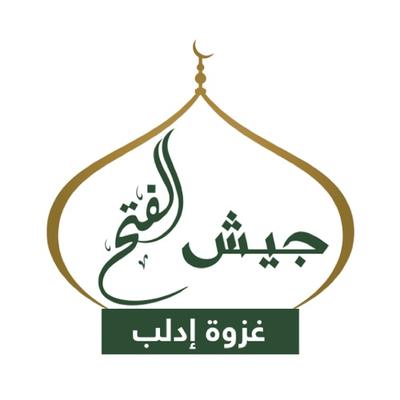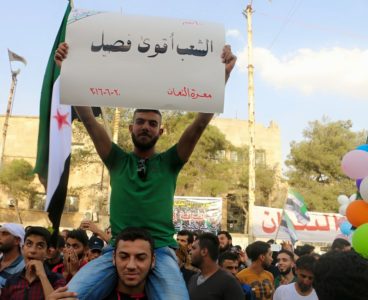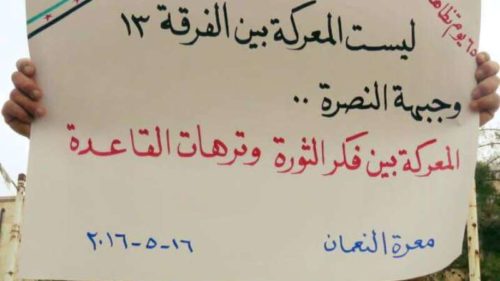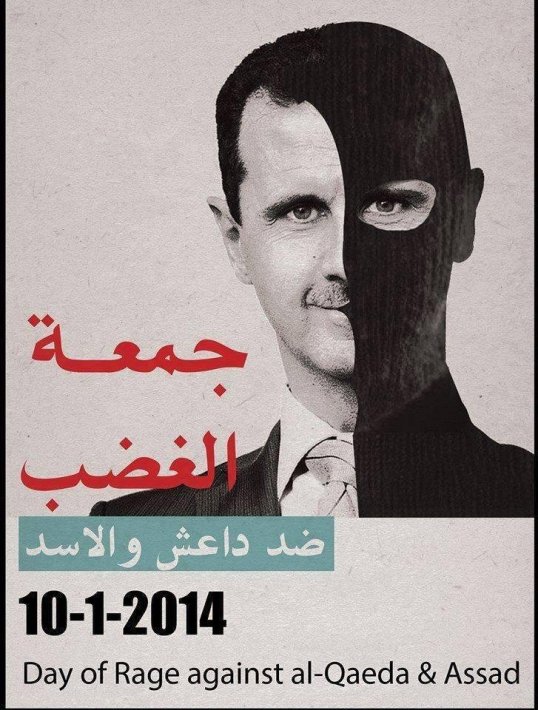First published by al-Jumhuriyah (The Republic). Written by Sadik Abdul Rahman. Translated by Alice Guthrie. Hyperlinks and videos added by this blog.
It was a melancholy dawn that broke on 13 March 2016 as far as the entire Free Syrian Army and the Syrian revolution were concerned, but it was particularly bleak for the broad swathes of opposition to al-Qaeda and its approach in the city of Maarrat al-Nu’man and the rural areas around Idlib. Syrians awoke that morning to find that al-Nusra Front [subsequently renamed Jabhat Fatih al-Sham (Levant Conquest Front)] had seized control of all the 13th Division bases in and around Maarrat al-Nu’man and requisitioned its military equipment, and that six 13th Division fighters had been martyred by members of the Jund al-Aqsa faction.
Men, women, and children come out against Al-Qaeda’s and Jund al-Aqsa’s attacks on the Free Syrian Army’s 13th Division.
But that dark day also marked the dawn of a nonviolent popular protest movement that has now been ongoing for more than a hundred days: an exceptional movement, continuing in extremely harsh and complex circumstances. Those in charge of it announced then — and still declare now — that they will continue protesting, no matter the price they have to pay, until their demands are achieved.
Military Confrontation and the Precursors to It
Demonstrations opposing the Syrian regime returned with a vengeance to scores of Syrian cities and towns in the wake of the truce that came into effect at the end of February. The flag of the Syrian revolution reappeared in squares and streets far and wide, and the demonstrations on 4 March – a Friday dubbed “the revolution continues” by activists – were pivotal.
On that day, when demonstrators came out on the streets of Maarrat al-Nu’man and scores of other towns and villages in Idlib province flying Syrian revolutionary flags, the executive force of “Jaysh Al-Fatih” [Army of Conquest] attacked the demonstrators in Idlib city, burnt Syrian revolutionary flags and detained a number of activists.

This widespread flying of the Syrian revolutionary flag caused tension across Northern Syria, especially in the areas under Jaysh Al-Fatih control, in Idlib city and in large parts of the rural areas around it. Jaysh Al-Fatih is an alliance of several factions, the most notable of which are al-Nusra Front and Ahrar al-Sham. Some of the other factions in Jaysh Al-Fatih were previously within the ranks of the Free Syrian Army. Jaysh Al-Fatih charter stipulates the removal of all factional flags, including the Syrian revolutionary flag, and also stipulates that only Jaysh Al-Fatih flags be flown. But the violence meted out by those supporting al-Nusra Front, and Jaysh Al-Fatih executive force’s insistence that its decree must apply to any demonstration taking place in the areas under its control, demonstrates al-Nusra Front’s strong desire to tighten its grip on all areas of Idlib province via Jaysh Al-Fatih.
March 10, 2016: Army of Conquest thugs take on peaceful protesters waving the revolutionary flag.
Maarrat al-Nu’man stood out among the areas of Idlib province not under JF control, as the 13th Division of the Free Syrian Army’s main headquarters were located there, and the city was also home to a strong school of thought opposing al-Qaeda ideaology and practice. Hundreds of locals are fighters in the 13th Division, which is not part of Jaysih Al-Fatih. The leader of the 13th Division, Lieutenant-Colonel Ahmad al-Saoud, attended the demonstration on 4 March along with a number of officers from the the 13th and Northern Divisions of the Free Syrian Army, and it was perhaps this that provoked the wrath of al-Nusra Front’s members and supporters in the city. Scores of them headed for Freedom Square (formerly known as Ba’ath Party Square) after the demonstration and began shooting into the air, chanting anti-truce slogans and lowering the revolutionary flags flying on the flagpoles of buildings looking over the square, as was reported by all the activists and Maarrat al-Nu’man residents we were in touch with.
On 10 March the Army of Conquest executive force had announced their ban on flying the revolutionary flag in areas under Army of Conquest control. During the demonstrations called for by activists on 11 March this rule was complied with to varying degrees, depending on how tight a grip the two factions of al-Nusra Front and Jund al-Aqsa had on the particular rural area of Idlib province in which the demonstration in question was taking place.
A confrontation broke out between demonstrators and al-Nusra Front elements during the 11 March demonstration in Maarrat al-Nu’man when al-Nusra Front elements accused 13th Division special assignments brigade commander Colonel Ali al-Samahi of throwing the al-Nusra Front flag on the ground, and physically assaulted him.
So a meeting was called to resolve the dispute, scheduled for seven o’clock in the evening on 12 March. When the time came for this supposed meeting to take place, however, groups of al-Nusra Front men — backed up by Jund al-Aqsa — had begun to attack the 13th Division bases and checkpoints in the towns of Haish, Khan Shaykhun, Jabaala, al-Ghadafa and the farms of al-Hamadia. Forming into huge convoys, they surrounded the city of Maarrat al-Nu’man – where the main headquarters of the Division were located — and began storming it from four sides. This was after a declaration had been issued stating that “The 13th Division faction is st orming the al-Nusra Front bases in Maarrat al-Nu’man” – categorically denied by the 13th Division. When dawn broke the following day al-Nusra Front and Jund al-Aqsa fighters had seized control of the majority of 13th Division bases, confiscated great quantities of their weapons and machinery, detained scores of their fighters, and killed six of their men.
Abdul Rahim al-Ma’mar is a media activist from Maarrat al-Nu’man who is close to the 13th Division and witnessed most of what took place. He has been participating on a more or less daily basis in the protests until now, and he told al-Jumhuriya:
“We were surprised during the meeting – which was convoked by the leader of al-Nusra Front Sheikh Abu Anis Harim – by news of al-Nusra Front elements attacking 13th Division bases and checkpoints in Haish, Khan Shaykhun, Jabaala and al-Ghadafa. Al-Nusra Front was backed up by Jund al-Aqsa fighters, who attacked the areas where the 13th Division is located around the al-Hamadia farms with mortars and Shilkas. This is where the major 13th Division arsenals are. The overnight assault was carefully planned: the first thing that the fighters did was to block the road between Maarrat al-Nu’man and al-Hamadia, and after that huge convoys moved towards Maarrat al-Nu’man from four directions.
“Sheikh Ahmad ‘Alwan, chair of the sharia court in Maarat al-Nu’man, and Sheikh Abdul Ma’ati al-As’ad, the leader of the Abdul Rahman Brigade of the Sham Legion, both tried to intervene and prevent the confrontation. But the attacking forces rejected any initiative of this kind, and insisted on continuing their assault.
“No assistance came from any faction within the Division. Members of the Sham Legion tried to act as a buffer between the two sides, but their small number combined with al-Nusra Front’s persistent fighting forced the Sham Legion to retreat in order to avoid bloodshed. After this civilians came out into the streets in protest. The 13th Division fighters attempted to defend themselves and their bases, but this turned out to be impossible, as the majority of Division fighters were spread out around the various battle fronts against the regime in the rural southern part of Aleppo and the rural North of Latakia. The Division had also sent nearly four hundred men into combat against Daesh in the rural southern part of Aleppo. In addition to all these factors there was the surprise attack on the Division checkpoints and bases outside Maarrat al-Nu’man mentioned above, and the isolation of Maarrat al-Nu’man city, being cut off from its surrounding areas and its arsenals of weapons and ammunition in the Hamadia farms areas.
“Al-Nusra Front fighters came back from the front lines of their battle against the regime with a great number of foreign fighters among them, intending to fight the 13th Division as though fighting “apostasy”. We heard that apparently they were telling anyone who objected to this that they were going to get closer to God by fighting the apostates – and they refused to heed any of the peace initiatives and calls that went out to them, or the civilian protests in Maarrat al-Nu’man.
“Sheikh Khaled Qaytaz and Abu Ahmad al-Zayn both tried to launch TOW missiles at the Division, aiming for al-Hamadia so as to take out the 13th Division positions there. So Sheikh Qaytaz was captured and al-Zayn’s car was targeted by anti-tank shells, causing him serious injuries, but he escaped with his life. Colonel Ali al-Samahi decided to surrender the bases in Maarrat al-Nu’man to the al-Nusra Front fighters in order to avoid bloodshed, and he was captured along with a number of Division men after al-Nusra Front fighters had offered safe passage to everyone except Colonel al-Samahi, as they considered him an apostate to whom the rule of God must be applied. This charge was rejected out of hand by the Division members.
“The morning of 13 March brought news of the capture of more than sixty-five Division fighters, and the attacking forces’ theft of most of the Division’s equipment, machinery and ammunition in Maarrat al-Nu’man and the area around al-Hamadia. This loss included the ammunition for the Division fighters stationed on the fronts in rural southern Aleppo, ambulances, a bulldozer used to clear rubble, as well as the stores of the Sanabel charity organisation and equipment from a hospital belonging to Médecins Sans Frontières (MSF). But the worst horror was the killing of six Division fighters when they refused to withdraw from al-Hamadia military camp by Jund al-Aqsa men, who went on to mutilate their corpses.”
The Popular Protest Movement: Circumstances and Trajectory
The funeral procession for the 13th Division martyrs took place on 13 March. The funeral turned into something more like an angry demonstration denouncing the al-Nusra Front assault on the 13th Division, and on that day the ongoing nonviolent but angry popular protest movement began. Its solid core is composed of the families of the 13th Division martyrs and prisoners, as well as a broad swathe of people opposed to al-Qaeda’s approach.
The following day angry demonstrators attacked the al-Nusra Front headquarters – in a former credit bank – setting it on fire and driving al-Nusra Front members out of it. They also nonviolently attacked the waterwheel checkpoint from which al-Nusra Front members withdrew. The two factions announced that same day their acceptance of the matter being heard by the sharia court, and al-Nusra Front suggested that the court be made up of the sheikhs Abdul Rizaq al-Mahdi, Abu Harith al-Masri and Abdullah al-Mahisni, all of whom are within easy reach of the court.
The 13th Division agreed to these names, suggesting the addition of Sheikh Ayman Haroush and Sheikh Abu Anis Kinakri, a suggestion that was rejected out of hand by al-Nusra Front. Despite this the 13th Division agreed that the court proceedings go ahead, and that the court be made up of the three sheikhs originally suggested by al-Nusra Front. The protest movement remained active over the following days, with demonstrators also attacking the headquarters of the Sham Nation faction – who had recently pledged allegiance to al-Nusra Front – on 15 March, to mark the fifth anniversary of the outbreak of the Syrian revolution.
After this the court that had been formed began its work to resolve the conflict, but it soon announced in a statement on Friday 25 March that it was stepping down from handling the matter, citing in its decision “the disputes and attitudes arising from both sides, and the non-appearance of Jund al-Aqsa before the judge.” The 13th Division then commented that the reason for the court’s dissolution was that “We demanded our stolen weapons and ammunition be handed over.” Al-Nusra Front refused to do this, announcing at the same time their lack of responsibility for Jund al-Aqsa’s behaviour.

The protest movement continued, turning into a regular daily protest. The basic demands being made were sharia arbitration and judgement of al-Nusra Front, the release of the detainees, and the return of the weapons and ammunition that were seized. The protestors’ slogans intensified and became more specific, so that they were now clearly targeting the al-Nusra Front Salafist approach, their leader al-Jolani, and Jund al-Aqsa – accusing both factions of being merely another face of Daesh. Meanwhile al-Nusra Front elements were concentrated at the edges of Maarrat al-Nu’man, avoiding any confrontation with the demonstrators.
Abdul Rahim al-Ma’mar says:
“Al-Nusra Front refused to be judged by sharia law, and refused to return the Division’s weapons. Some Division elements were still fighting the regime on the front lines with what remained of their weapons, and particularly with the TOW missiles that al-Nusra Front had not seized; but the majority of them were languishing at home, far from the front lines on which they should have been stationed, due to the lack of weapons.
The 13th Division no longer had an influential armed presence in Maarrat al-Nu’man. The ongoing protest movement was not a 13th Division movement as such: it was made up of Maarrat al-Nu’man locals, with a central of 13th Division elements and the families and friends of those who had been attacked by al-Nusra Front. Many al-Nusra Front supporters claimed that the dispute was just a local family feud. But everything that happened, and al-Nusra Front’s subsequent refusal of any solution that preserved the people of Maarrat al-Nu’man’s dignity as well as the 13th Division’s dignity and its weapons, proved that the attack was prearranged. It was obviously the conclusion of what al-Nusra Front had done to each of the Free Syrian Army factions in succession, in order to implement al-Qaeda’s plan in Syria.
Al-Nusra Front also took steps to diffuse popular anger, among which were the release of all detainees including, Sheikh Khaled Qaytaz and Colonel Ali al-Samahi, and an initiative presented to the families of the six martyrs consisting of an indemnity for their deaths, in return for the families ceasing to participate in the protests. The families’ response to this offer was that their issue was a private one, but that there was also a public issue which must be solved first: al-Nusra Front’s tyranny, and the requisitioning of the people of Maarat al-Nu’man’s weapons. This response was what proved the solid popular depth of the movement.”
But how can the movement succeed in continuing at a time when it seems clear that no military power exists that is capable of deterring al-Nusra Front and Jund al-Aqsa? And how should the fact that al-Nusra Front is not continuing its battle to wipe out the 13th Division be interpreted, if what the Front did was a continuation of what it had done to the Hazzm Movement, the Syrian Revolutionaries Front, and other factions previously?
Al-Ma’mar adds:
“Al-Nusra Front elements cannot commit a massacre in Maarrat al-Nu’man because that would cause a further slump in their already decreased popularity – the popular movement in our city is inclusive and broad, so it would be hard to confront it without committing a massacre. Moreover the city of Maarat al-Nu’man does not have the great military importance that might provoke al-Nusra Front to launch an attack on it. Instead al-Nusra Front is laying bets on how long the protest movement takes to come to an end, especially given that the Front has already tightened its grip on most of the rural areas of Idlib via its ally Jayish Al-Fatih.
Al-Nusra Front was not able to finish off the 13th Division because of the broad popular support the Division has, which is not the case for the Syrian Revolutionaries Front, for example, who were accused by most people of corruption. Al-Nusra Front is counting on time doing its dirty work, along with the isolation the Maarrat al-Nu’man movement has been forced into. This isolation is caused by the extreme fear of al-Nusra Fronts bombs and IEDs and of the takfiri religious discourse of jihadi Salafism, and of any widespread internal confrontation that might give the Assad regime the opportunity to advance.
Al-Nusra Front is betting on time and amnesia, but we won’t allow this to happen: our protest movement will continue until our demands are achieved, no matter the price, and no matter how long it takes.”
Two questions come to mind: the first concerns those who are organising the movement and their relationship with the 13th Division, and the second concerns the 13th Division’s situation and future.
Al-Ma’ara says:
“There is no committee that has declared itself in charge of organising the movement, but there is an informal one with one or two 13th Division members in it. But that doesn’t negate the fact that this is a people’s movement, not a factional one, as the rest of the committee members are civilians, they are ordinary people from Maarrat al-Nu’man. Also, it’s only natural that those affected by an attack be at the heart of the movement that protests about that attack. But the movement is not concerned with the 13th Division in itself – rather, it’s concerned with the necessity of putting a limit on the predominance and oppression of al-Nusra Front, and with defending the idea of the Free Syrian Army’s existence and the revolutionary flag. We gave hundreds of martyrs for that flag. The movement is also concerned with achieving the goal of freedom – the goal that brought us out against the Assad regime in the first place.
As for the 13th Division, it continues to fight with whatever weapons its fighters have left in their hands. This includes fighting on the rural front lines in the south of Aleppo province, where the Army of Conquest are to be found, because our principal battle will continue to be against the Assad regime no matter what happens. The 13th Division also continues to offer its services to the civilians wherever they are, and in whatever way possible. We hope that the circumstances will change – that the Division’s weapons will be returned to it, so that it can get back to fighting the regime as it was doing.”
The Movement’s Prospects and the Potential for Expansion
The truce collapsed, just like al-Nusra Front wanted it to, and Maarrat al-Nu’man has recently been subjected to a number of raids by Russian planes and Syrian regime planes, one of which targeted the popular vegetable market, felling tens of victims. At the same time Army of Conquest factions, lead by al-Nusra Front, achieved several victories in rural southern Aleppo in collaboration with other factions including the 13th Division itself. But at the same time as these military achievements, al-Nusra Front began to escalate its violations in rural Idlib, with actions such as the detention of a number of local council members in Kafranbel and the execution of a young man from Sarqib, Mohamed Abeed, in Salqin.
These violations brought popular anger to boiling point, as represented in the sit-ins witnessed in Kafranbel and Saraqib. But the movement was still limited and operating on a small scale, without clear slogans. Perhaps among the reasons for this limitation was the horror caused by the IEDs that had targeted many people lately, including leaders of Ahrar al-Sham, and the fear of any internal confrontation while the factions were engaged in battle against the regime in rural South Aleppo and Syrian regime planes and Russian planes were stepping up their slaughter in all of Idlib both urban and rural.
Despite all these factors, the movement in Maarrat al-Nu’man still continues. But it still seems to be completely isolated, especially in terms of media, with most revolutionary media platforms and writers in Idlib and elsewhere ignoring it.
Someone from Saraqib who declined to give his name for security reasons tells al-Jumhuriya:
“News reached us of an al-Nusra Front attack on the 13th Division in Maarrat al-Nu’man, and of the protests that followed it. We were asked to buy into the idea that this was all just some quarrel between families, but it was clear to me and to many of my friends what was going on, from the first moment. Al-Nusra Front intends to eliminate the 13th Division just like it has already eliminated a number of factions in the Free Syrian Army – it doesn’t want the Free Syrian Army to exist at all, it wants to have dominion over all the liberated areas. Despite how clear this is to everybody, and despite the fact that there is broad sympathy with the 13th Division and with the movement in Maarrat al-Nu’man, people are in such a state that they are not prepared to risk throwing themselves into something like this – especially not after we have witnessed IEDs claiming lives, and seen the terrifying results of internal conflict in the Eastern Ghouta.
Al-Nusra Front maintain their dominon using fear tactics, religious discourse, and the ready accusation of apostasy and the handy label of infidel. It is not possible to confront al-Nusra Front unless there is a widespread and overwhelming state of popular anger and restlessness, or unless one of the major factions takes a decision to rebel against al-Nusra Front.”
It does not seem as if the current circumstances are favourable for the movement to spread beyond Maarrat al-Nu’man, but at the same time neither does it seem that the demonstrators in Maarrat al-Nu’man are on the verge of surrendering. Rather, what they have achieved has turned into something that cannot easily be reversed, as al-Nusra Front no longer has free rein to implement its plans as it had previously, and for the first time it is failing to eradicate a faction that it has announced its intention to eradicate. Similarly it does not seem that the twin factors of time and isolation are playing a role in making the activists of Maarrat al-Nu’man retreat from their movement – the slogan used in the celebration of one hundred days of protest was “The grandchildren of al-Ma’arri [a notable Arab philosopher and poet of the 11th century, and a native of Maarrat Al-Numan, known in his time as a freethinker] are rising up.”

There is no doubt that the course upcoming events will take is dependent on the protest movement continuing, and on its potential to spread to new cities and towns, drawing them into Maarrat al-Nu’man’s uprising. But it is also dependent on the political circumstances and the developments in the field, and linked to the negotiation process and the policies of the international and regional sides involved. Forcing the Assad regime to make serious concessions would be crucial in creating the right climate for the decline and retreat of the al-Qaeda in Syria project. And this, it seems, is what no one in the world intends to do.
